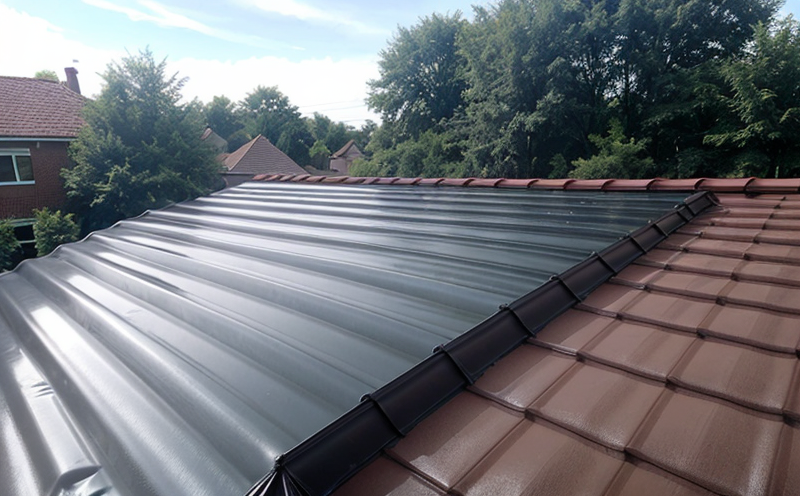ISO 37 Rubber Waterproofing Membrane Tensile Testing
The ISO 37 standard specifies a method for determining the tensile properties of rubber waterproofing membranes. This test is crucial in ensuring that roofing and waterproofing materials meet stringent performance requirements, particularly under conditions where they are subjected to tension forces. In the context of building and infrastructure testing, this test plays a pivotal role in quality assurance processes by validating the durability and integrity of waterproofing membranes.
The tensile properties tested include ultimate tensile strength (UTS), elongation at break, and maximum breaking force. These parameters are critical for assessing how these materials will perform under various stress conditions during their service life. For instance, a rubber membrane used in roofing may experience significant tensile stresses due to the expansion and contraction of the building envelope as temperatures fluctuate over time.
The test procedure involves preparing the specimen according to ISO 37 standards, which typically include cutting the material into standard dimensions (e.g., width x length) and ensuring that they are free from defects. The sample is then clamped into a tensile testing machine designed for rubber materials. The machine applies incremental loads until the sample breaks, recording the force at various stages.
The results of this test provide valuable insights into the material’s ability to withstand stress without failure, which is essential for long-term performance in roofing and waterproofing applications. Compliance with ISO 37 ensures that the product meets international standards, enhancing confidence among stakeholders such as architects, engineers, and building owners regarding the product's reliability.
For quality managers and compliance officers, this test offers a reliable method to ensure that all rubber waterproofing membranes comply with specified performance criteria. R&D engineers can use these results to optimize formulations for better tensile properties, while procurement teams benefit from the assurance of consistent quality in their supply chain.
- Why Choose This Test: It ensures compliance with international standards, providing confidence in product reliability and durability.
- Benefits: Enhanced performance under stress conditions, ensuring long-term integrity of roofing systems.
In summary, ISO 37 rubber waterproofing membrane tensile testing is an indispensable tool for quality assurance in the building and infrastructure sector. By providing critical data on material properties, this test supports informed decision-making throughout the product lifecycle from design to installation and maintenance.
Why Choose This Test
- International Standards: Adherence to ISO 37 guarantees compliance with international regulations, enhancing credibility in both domestic and export markets.
- Quality Assurance: By ensuring that rubber waterproofing membranes meet stringent tensile requirements, this test supports quality assurance processes throughout the product lifecycle.
- Reliability: The results of ISO 37 testing provide reliable data on material performance under tension, which is crucial for long-term durability in roofing and waterproofing applications.
The choice of this test is driven by its ability to deliver precise, repeatable results that are critical for maintaining high standards in the building and infrastructure sector. Quality managers and engineers benefit from the confidence that comes with knowing their materials meet international benchmarks, while R&D teams can leverage these data points to innovate and improve product formulations.
International Acceptance and Recognition
The ISO 37 rubber waterproofing membrane tensile test is widely accepted across the globe due to its stringent criteria and consistent results. Many countries have adopted this standard as a benchmark for quality, ensuring that products meet international standards of performance and reliability.
The acceptance of ISO 37 in various regions has led to increased trust among stakeholders, including architects, engineers, and building owners. Compliance with this standard is not only a requirement for export but also an indication of the product’s robustness and durability under real-world conditions. This recognition underscores the importance of adhering to international standards like ISO 37 in ensuring consistent quality across different markets.
By choosing this test, companies can leverage its global acceptance to enhance their market presence and gain competitive advantages. The standard's rigorous requirements ensure that only high-quality products pass muster, thereby building a reputation for excellence among clients and industry peers.
Environmental and Sustainability Contributions
The ISO 37 rubber waterproofing membrane tensile test contributes to environmental sustainability by ensuring the longevity and integrity of roofing systems. Long-lasting materials reduce the frequency of replacements, leading to lower waste generation and associated environmental impacts.
- Reduced Maintenance Costs: By selecting membranes that pass stringent tensile tests, buildings can expect fewer maintenance issues, resulting in cost savings and reduced resource consumption.
- Eco-Friendly Materials: The use of compliant materials aligns with broader sustainability goals by promoting the use of durable, high-performance products.
The test's focus on durability also supports lifecycle assessment efforts, helping to minimize the environmental footprint associated with roofing and waterproofing projects. By choosing ISO 37 compliant membranes, stakeholders contribute to a more sustainable built environment, reducing the need for frequent replacements and associated emissions from transportation and manufacturing.





